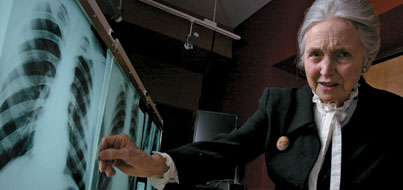Interview with Margaret Becklake by Jennifer Towell

As a young physician in her native South Africa, Margaret Becklake began to suspect that pneumoconiosis, a lung disease caused by the inhalation of mineral dust, was not the only chronic lung disease disabling hard rock miners.
“I was a young investigator, and I thought I’d find the answer quite quickly,” recalls the Professor Emeritus of the Departments of Medicine, of Epidemiology and Biostatistics and of Occupational Health.
But her research challenged long-held beliefs and the way in which worker compensation boards operated. In this interview, Dr. Becklake spoke about the pitfalls and rewards of an area of research she has pursued with conviction throughout her career.
Identifying the question
“The focus had always been on the silica dust but little attention was paid to other dust raised in the mining atmosphere. It is that component of the dust that I have been interested in, beginning in the 1950s when I was working in Johannesburg in the Miners’ Pneumoconiosis Bureau.
“Miners whose chest X-rays showed silicosis, but were not disabled, still received compensation. Other miners who were disabled, but whose chest X-rays did not show silicosis, were not eligible for compensation. Here was a paradox not explained by current knowledge, and I followed that lead.”
Looking for answers
“In South Africa, my research had been conducted in the gold mining industry on which the country’s economy was built at the time. When I came to Canada, I moved into other fields but retained my interest in airway disease.
“When Dr. Corbett McDonald of McGill’s Department of Epidemiology and Health launched a research program into the health of asbestos miners and millers in Quebec, he invited me to set up a laboratory to study their lung function. The same question arose as in South Africa. Were there ill-health effects of exposure to the other dust produced when the asbestos was cleaved from rock?
“At the time, chronic obstructive pulmonary disease (COPD), the condition from which these miners suffered, was attributed only to cigarette smoking and little thought was given to other causes.”
Challenges along the way
“I am often asked if being a woman made it more difficult for me to pursue this line of research. I have always worked in a collegial fashion. Originally there weren’t many other women in academic research, but I’ve always felt that I was given a fair hearing by colleagues, men and women. If we disagreed on this issue, we agreed on others.
“As a young investigator, I was not used to the fact that one must expect three, four or five rejections of a manuscript before publication. The importance of getting published is that one’s findings are in the international literature and accessible to others working in the field. Some of our early data published in technical reports for the government was not useful because such reports are not easily accessible.”
Seeing the hard work pay off
“An early breakthrough came when I took part in a conference in which the participants were mainly individuals who didn’t agree with our data or the interpretation put upon it. I doubt whether the paper on its own would have been published but the conference proceedings were published in a much respected journal in 1989. During the 1990s, others came to the same conclusion as I had.
“A second big break came when the American Thoracic Society asked me to sit on a committee to prepare a statement on “The Occupational Contribution to the Burden of Airway Disease.” When it was published in 2003, in the Society’s American Journal of Respiratory and Critical Care Medicine, it put the concept on the map.
“I’ve seen the practical results in cases that have gone to the worker compensation board in Quebec, and cases are becoming recognized in other jurisdictions. The data from the South African mining experience and the Quebec mining experience are now in the general literature. This implies wide acceptance of the concept that COPD – as well as pneumoconiosis – is an occupational disease of miners and others exposed to mineral dusts at work.”
